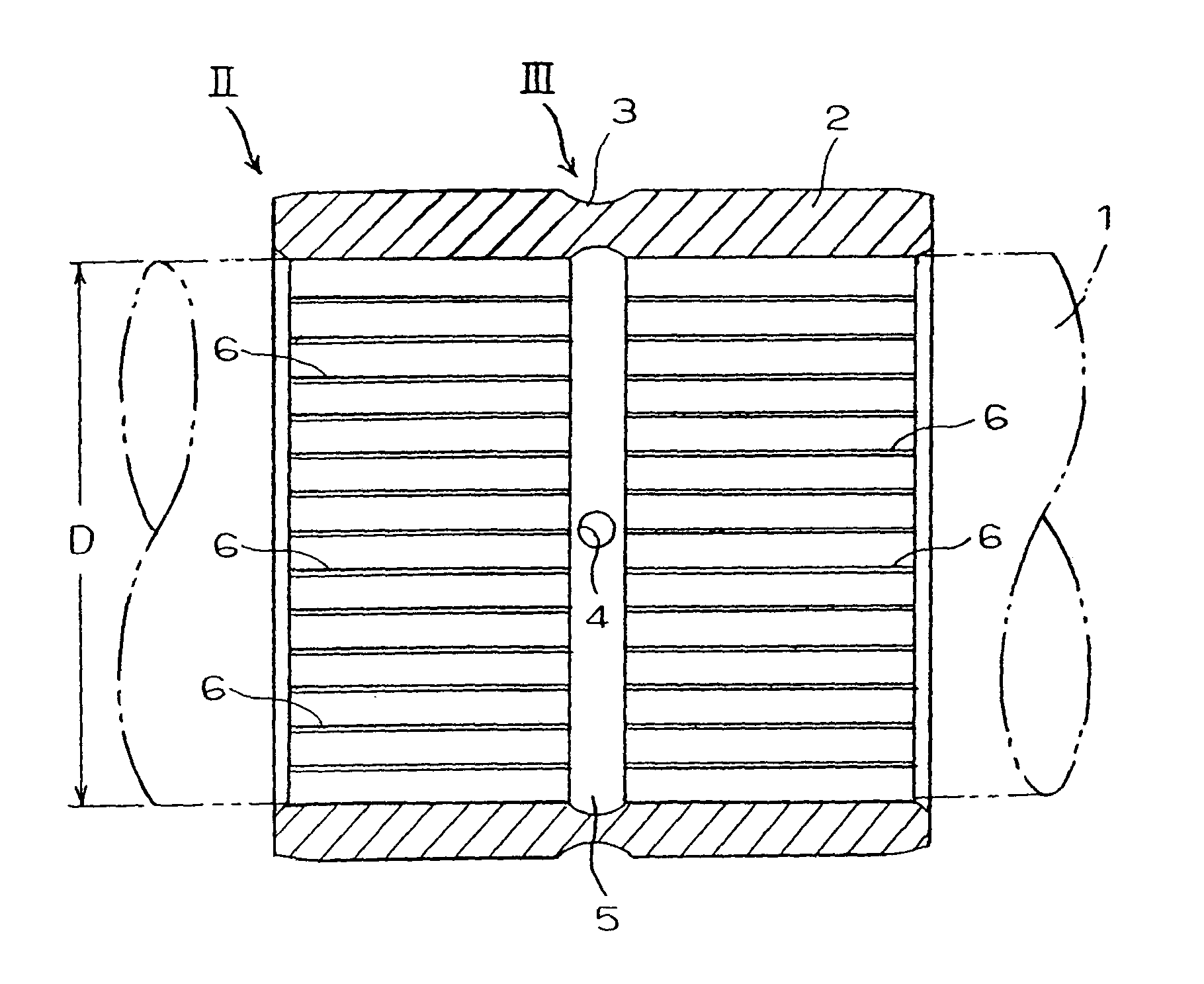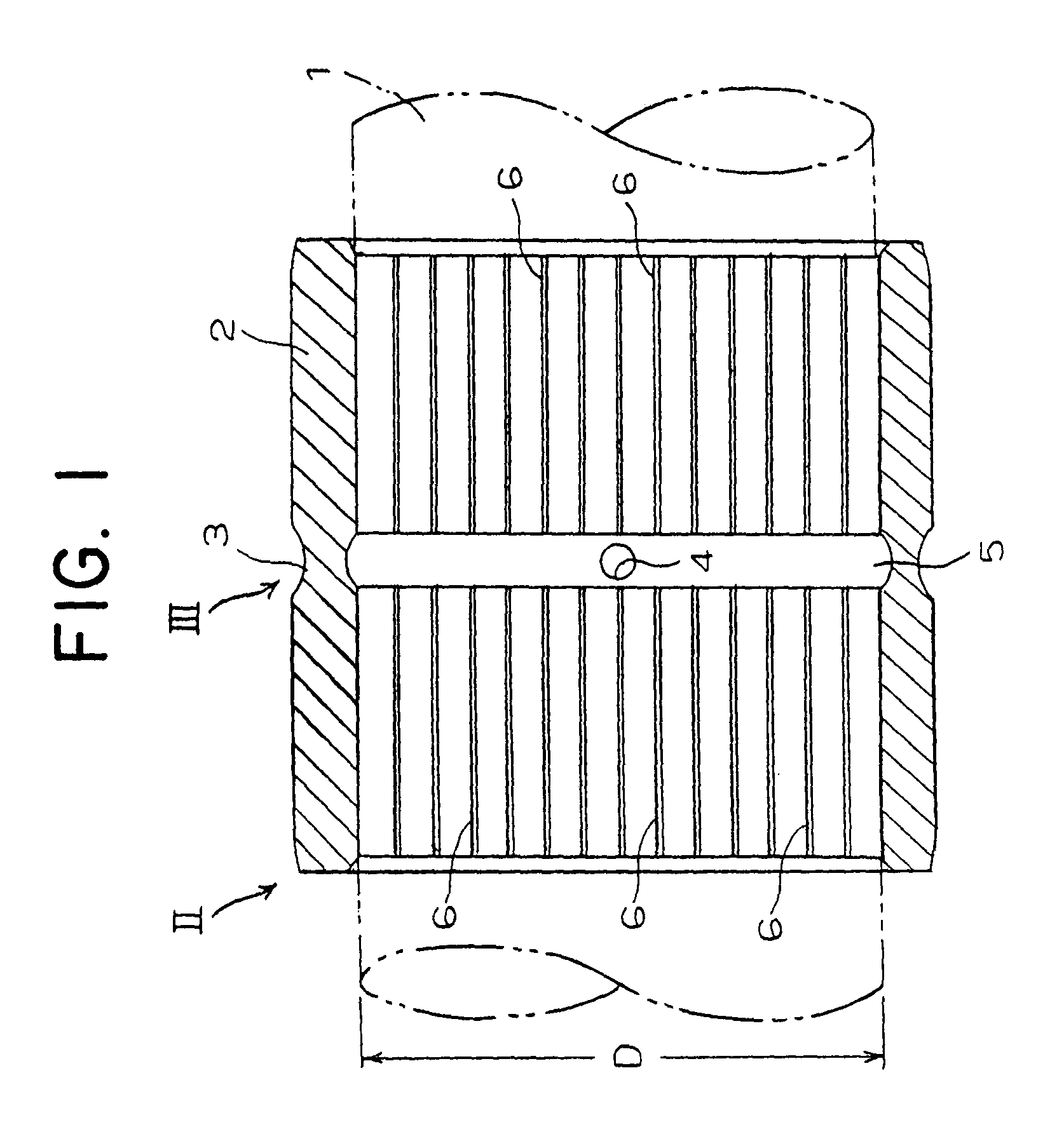Bearing device
a bearing and ring technology, applied in the direction of bearings, shafts and bearings, rotary bearings, etc., can solve the problems of abnormal wear, abrasion, seizure, and difficulty in obtaining the desired seizure load
- Summary
- Abstract
- Description
- Claims
- Application Information
AI Technical Summary
Benefits of technology
Problems solved by technology
Method used
Image
Examples
first embodiment
[0035]FIGS. 1 to 5 schematically show a structure of a bearing constituting a portion of a bearing device according to a representative first embodiment of the present invention. FIG. 1 is a schematic sectional view of the bearing. FIG. 2 is an enlarged view showing an end portion of the bearing at an arrow II in FIG. 1. FIG. 3 is an enlarged view showing a peripheral portion of the bearing at an arrow III in FIG. 1. FIG. 4 is an enlarged view showing an oil-supply groove portion of the bearing. FIG. 5 is an enlarged sectional view of the oil-supply groove portion taken along a line IV—IV in FIG. 4.
[0036]In these drawings, the bearing device is applied to the connection part of the utility machine which connects an arm and a bucket mounted to an excavator (not shown). The bearing device includes a journal shaft 1 as a shaft member. The journal shaft 1 is fixed and supported between a pair of brackets of the bucket (not shown). A cylindrical boss (not shown) is rotatably fitted over ...
second embodiment
[0051]FIGS. 6 and 7 show a bearing which is a partial constituting member of the bearing device of the invention. FIG. 6 is a vertical sectional view of the bearing, and FIG. 7 is an enlarged view showing oil-supply groove portions of the bearing.
[0052]A structure of the second embodiment is basically the same as that of the bearing device of the first embodiment except that the inner peripheral surface of the bush 2 which is a bearing is formed with second oil-supply groove portions 6 which are inclined at a predetermined angle α. Therefore, in FIGS. 6 and 7, substantially the same members as those in the first embodiment are designated with the same names and numerals, and detailed explanation of these members is omitted.
[0053]In FIGS. 6 and 7, the second oil-supply groove portions 6 which are inclined with respect to the axial direction of the bush at the predetermined inclination angle α are helically formed on the inner peripheral surface of the bush 2, and a plurality of the s...
experiment example 1
[0061
[0062]As machining conditions by a conventional NC lathe, or by a broaching machine, or kurling machining conditions by a lathe, machining intervals of the grooves were set to three values, i.e. 10° (6.1 mm, groove area ratio of 8%), 5° (3.05 mm, groove area ratio of 16%) and 2.5° (1.53 mm, groove area ratio of 32%). A plurality of arc groove portions each having a width of 0.5 mm and a depth of 0.2 mm were formed on an inner peripheral surface of a cylindrical bush 2 having an inner diameter of a cylindrical portion of 70 mm, an outer diameter of the cylindrical portion of 85 mm and a length of the cylindrical portion of 85 mm in parallel to the axial direction of the bush. These bushes 2 were subjected to quenching, and a surface hardness of the bush 2 was set to HRC 58.
[0063]Next, the bushes 2 were press-fitted two each into a bush case at a distance of 375 mm from each other in parallel, and journal shafts 1 each having a diameter of about 70 mm were mounted into the two bu...
PUM
 Login to View More
Login to View More Abstract
Description
Claims
Application Information
 Login to View More
Login to View More - R&D
- Intellectual Property
- Life Sciences
- Materials
- Tech Scout
- Unparalleled Data Quality
- Higher Quality Content
- 60% Fewer Hallucinations
Browse by: Latest US Patents, China's latest patents, Technical Efficacy Thesaurus, Application Domain, Technology Topic, Popular Technical Reports.
© 2025 PatSnap. All rights reserved.Legal|Privacy policy|Modern Slavery Act Transparency Statement|Sitemap|About US| Contact US: help@patsnap.com



